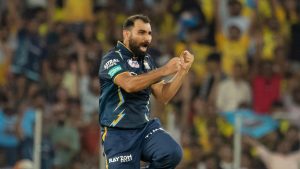India is going to participate in the 2023 ODI Cup, and they will have to win two more matches in order to put an end to their ten-year ICC trophy drought. First in line is the semifinals against New Zealand. On Wednesday, the two sides will meet at Wankhede Stadium in Mumbai.
In the league round of the competition, India and New Zealand engaged in a fierce match. In Dharamshala, the Men in Blue pulled off a nerve-wracking run chase, winning by four wickets. It was the greatest challenge the hosts had encountered in the current World Cup, even if it was another victory for them.
New Zealand’s capacity to step up in big times, along with the painful memories of the 2019 World Cup semi-finals, makes it a more tough fixture for India than it appears on paper. The Men in Blue must be mindful of New Zealand’s well-rounded group, which is tough but not invincible.
On that vein, let us look at three New Zealand flaws that India may exploit in the 2023 World Cup semi-final.
1. Over-reliance on the top order
There were concerns about New Zealand’s top-order power, particularly after Kane Williamson’s injury. Devon Conway was the only dependable candidate on paper, and oddly, he has taken a back seat in the events thus far.
Rachin Ravindra, an all-rounder, has been an unexpected World Cup surprise. He has already written history by having the most productive season for a batter under the age of 25. Ravindra has three hundreds so far and, along with Williamson, is already a backbone of the Blackcaps’ batting.
The New Zealand captain has battled injury worries but has not been even slightly rusty. He has played with the same zeal, and the squad will rely on him when things go tough.
The ability of the middle order to sustain pressure and take on strong spin bowling, on the other hand, will be the key question. It was the same department that let them down against India in the league stage, resulting in a below-par total from a good foundation and their first loss of the season.
While Daryl Mitchell and Tom Latham are great spinners, they will go up against an in-form Kuldeep Yadav and Ravindra Jadeja.
Furthermore, while there is no doubt about Glenn Phillips’ hitting talent, he falls a little short when it comes to building an innings when the team is under pressure with plenty of overs to spare against a great opponent.
2. Second spinner woes
Mitchell Santner has clearly been one of the tournament’s greatest spinners. He has been able to exert control in the middle overs and take wickets at regular intervals to keep the Blackcaps at bay. However, the subcontinent circumstances necessitate the presence of a second spinner who is similarly skilled.
Rachin Ravindra, Glenn Phillips, and Ish Sodhi are the primary spinners for New Zealand. However, Sodhi has only played one game in the competition, while the rest of the players are all-rounders rather than frontline possibilities.
Ravindra has only taken five wickets in eight games at a 5.67 economy rate. Phillips has outperformed expectations as a part-time option, but how much influence he can have against a dominating, tough Indian hitting lineup loaded with right-handed batters remains to be seen.
Playing Sodhi, on the other hand, will jeopardize the Kiwis’ batting depth. While the leg-spinner’s batting has improved, putting him in a big semi-final out of nowhere would be a bad move.
3. Semi-final woes
Along with India, New Zealand will face significant pressure. In recent years, the Men in Blue have struggled in knockout matches, but so has New Zealand.
With only two final appearances and no championship to their record, this is New Zealand’s ninth World Cup semi-final appearance in 13 attempts.
The Wankhede Stadium, which is sure to be a sea of blue, lends support to the hosts, so they will also have to contend with an intense atmosphere there. It’ll be difficult to play in a setting this unbalanced.
